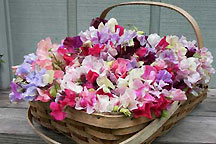
Growing Sweet Peas in the Midwest
 It’s unfortunate that sweet peas have a reputation for being difficult to grow in the Midwest, because these lovely flowers offer both exquisite perfume and a wide range of colors from pastels to vivid hues. True, growing sweet peas in our region can be a little more challenging , but the trick is in knowing when to plant them and how to take care of them.
It’s unfortunate that sweet peas have a reputation for being difficult to grow in the Midwest, because these lovely flowers offer both exquisite perfume and a wide range of colors from pastels to vivid hues. True, growing sweet peas in our region can be a little more challenging , but the trick is in knowing when to plant them and how to take care of them.The “when” for our region is “early.” The plants need to be well established before hot weather arrives. Plant the seeds outside just as soon as the soil dries out enough to be workable, and don’t worry about late frosts, which won’t hurt the plants. Better yet, start seeds indoors a month earlier in small individual pots and transplant them outside after they’re up and growing.

I usually soak any type of pea seeds, including sweet peas, overnight before planting. Renee said it’s even better to skip the soaking and instead nick each seed with nail clippers before planting. “No need to gouge out a piece of the seed,” she said. “Just make a tiny opening for moisture to enter naturally. This nicking process takes some extra time but will guarantee great germination.”
Traditional sweet peas are clasping vines that climb by wrapping their tendrils tightly around anything small, such as wire, string, or netting. There are also some short, mounding varieties sized just right for growing in containers or window boxes.
All sweet peas require well-drained soil. If yours isn’t, planting on a berm or in a container will solve the problem.
Sweet peas also need sun, but in our region a bit of shade in the hot afternoon is a good thing. Good air circulation helps keep mildew at bay, so be sure to thin seedlings to 5 or 6 inches apart.
To keep sweet peas going for the longest possible time, water whenever rains fail and pick bouquets early and often. The more you cut, the more they’ll bloom and the slower they’ll be to go to seed and die back. Harvest stems when the lowest blossom on each stem just begins to open.
When heat gets the best of annual sweet peas, I’m always grateful for the perennial type. They have no fragrance and they come in only white or shades of pink, but the plants are easy and drought tolerant, and the blossoms are just as pretty.
 It’s unfortunate that sweet peas have a reputation for being difficult to grow in the Midwest, because these lovely flowers offer both exquisite perfume and a wide range of colors from pastels to vivid hues. True, growing sweet peas in our region can be a little more challenging , but the trick is in knowing when to plant them and how to take care of them.
It’s unfortunate that sweet peas have a reputation for being difficult to grow in the Midwest, because these lovely flowers offer both exquisite perfume and a wide range of colors from pastels to vivid hues. True, growing sweet peas in our region can be a little more challenging , but the trick is in knowing when to plant them and how to take care of them.The “when” for our region is “early.” The plants need to be well established before hot weather arrives. Plant the seeds outside just as soon as the soil dries out enough to be workable, and don’t worry about late frosts, which won’t hurt the plants. Better yet, start seeds indoors a month earlier in small individual pots and transplant them outside after they’re up and growing.

I usually soak any type of pea seeds, including sweet peas, overnight before planting. Renee said it’s even better to skip the soaking and instead nick each seed with nail clippers before planting. “No need to gouge out a piece of the seed,” she said. “Just make a tiny opening for moisture to enter naturally. This nicking process takes some extra time but will guarantee great germination.”
Traditional sweet peas are clasping vines that climb by wrapping their tendrils tightly around anything small, such as wire, string, or netting. There are also some short, mounding varieties sized just right for growing in containers or window boxes.
All sweet peas require well-drained soil. If yours isn’t, planting on a berm or in a container will solve the problem.
Sweet peas also need sun, but in our region a bit of shade in the hot afternoon is a good thing. Good air circulation helps keep mildew at bay, so be sure to thin seedlings to 5 or 6 inches apart.
To keep sweet peas going for the longest possible time, water whenever rains fail and pick bouquets early and often. The more you cut, the more they’ll bloom and the slower they’ll be to go to seed and die back. Harvest stems when the lowest blossom on each stem just begins to open.
When heat gets the best of annual sweet peas, I’m always grateful for the perennial type. They have no fragrance and they come in only white or shades of pink, but the plants are easy and drought tolerant, and the blossoms are just as pretty.



